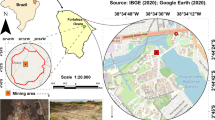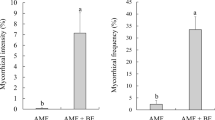Abstract
This greenhouse study aimed to determine the effect of colonization by the arbuscular mycorrhizal (AM) fungus (Glomus intraradices Schenck & Smith) on the “wild” tobacco (Nicotiana rustica L. var. Azteca), under soil–zinc (Zn) conditions. Plants of N. rustica were grown in AM or non-AM inoculated substrate and subjected to four soil–[Zn] concentrations (0, 50, 100, and 250 mg Zn kg−1 dry soil). The AM root colonization increased markedly from 14 to 81% with the increasing soil–[Zn] and the mycorrhizal structures were significantly more abundant at the highest soil–[Zn], suggesting that Zn may be involved directly or indirectly in AM root colonization. In addition, total Zn content or Zn concentrations in shoots and roots were shown to increase as soil–[Zn] increased in both AM and non-AM plants. As for the growth parameters studied, there were no significant differences between treatments despite the increase in Zn content or concentration. The AM roots subjected to the highest soil–[Zn] had a significant reduction by about 50% of total Zn content and Zn concentration compared to non-AM roots. Still, the relative extracted Zn percentage decreased dramatically as soil–[Zn] increased. Soil pH was significantly lower in non-AM than AM treatments at the highest soil–[Zn]. In summary, AM plants (particularly roots) showed lower Zn content and concentration than non-AM plants. In this regard, the AM fungi have a protective role for the host plant, thus playing an important role in soil-contaminant immobilization processes; and, therefore, are of value in phytoremediation, especially when heavy metals approach toxic levels in the soil.

Similar content being viewed by others
References
Barceloux DG (1999) Zinc. J Toxicol Clin Toxicol 37:279–292
Bradford MM (1976) A rapid and sensitive method for the quantification of microgram quantities of proteins utilizing the principle of protein dye-binding. Ann Biochem 72:248–254
Bradley R, Burt AJ, Read DJ (1981) Mycorrhizal infection and resistance to heavy metal toxicity in Calluna vulgaris. Nature 292:335–337
Bradley R, Burt AJ, Read DJ (1982) The biology of mycorrhiza in the Ericaceae: VIII. The role of mycorrhizal infection in heavy metal resistance. New Phytol 91:197–209
Bruinsma J (1963) The quantitative analysis of chlorophylls a and b in plant extracts. Photochem Photobiol 72:241–249
Burleigh SH, Kristensen BK, Bechmann IE (2003) A plasma membrane zinc transporter from Medicago truncatula is up-regulated in roots by Zn fertilization, yet down-regulated by arbuscular mycorrhizal colonization. Plant Mol Biol 52:10–77–1088
Chaney RL (1993) Zinc Phytotoxicity. In: Robson AD (ed) Zinc in soils and plants. Kluwer, Dordrecht, The Netherlands, pp 135–150
Charest C, Clark G, Dalpé Y (1997) The impact of arbuscular mycorrhizae and phosphorus on the growth of two turfgrass species. J Turfgrass Manag 2:1–14
Chen BD, Christie P, Li XL (2001) A modified glass bead compartment cultivation system for studies on nutrient and trace metal uptake by arbuscular mycorrhiza. Chemosphere 42:185–192
Chen BD, Li XL, Tao HQ, Christie P, Wong MH (2003) The role of arbuscular mycorrhiza in zinc uptake by red clover growing in a calcareous soil spiked with various quantities of zinc. Chemosphere 50:839–846
Dalpé Y (1993) Vesicular–arbuscular mycorrhizae. In: Carter MR (ed) Soil sampling and methods of analysis, 3rd edn. Can Soc Soil Sci, CRC, Boca Raton, Fla, pp 287–301
Davies FT, Puryear JD, Newton RJ, Egilla JN, Saraiva Grossi JA (2001) Mycorrhizal fungi enhance accumulation and tolerance of chromium in sunflower (Helianthus annuus). J Plant Physiol 158:777–786
Davies FT, Puryear JD, Newton RJ, Egilla JN, Saraiva Grossi JA (2002) Mycorrhizal fungi increase chromium uptake by sunflower plants: influence on tissue mineral concentration, growth, and gas exchange. J Plant Nutr 25:2389–2407
Gildon A, Tinker PB (1981) A heavy metal tolerant strain of mycorrhizal fungus. Trans Br Mycol Soc 77:648–649
Gildon A, Tinker PB (1983) Interactions of vesicular–arbuscular mycorrhizal infection and heavy metals in plants: I. The effects of heavy metals on the development of vesicular–arbuscular mycorrhizae. New Phytol 95:147–161
González-Guerrero M, Azcón-Aguilar C, Mooney M (2005) Characterization of a Glomus intraradices gene encoding a putative Zn transporter of the cation diffusion facilitator family. Fungal Genet Biol 42:130–140
Hovsepyan A, Greipsson S (2004) Effect of arbuscular mycorrhizal fungi on phytoextraction by corn (Zea mays) of lead-contaminated soil. Int J Phytoremediation 6:305–321
Jackson ML (1973) In: Soil chemical analysis. Prentice Hall, New York, USA
Janoušková M, Vosatká M (2005) Response to cadmium of Daucus carota hairy roots dual cultures with Glomus intraradices or Gigaspora margarita. Mycorrhiza 15:217–224
Joner EJ, Briones R, Leyval C (2000) Metal-binding capacity of arbuscular mycorrhizal mycelium. Plant Soil 226:227–234
Kothari SK, Marschner H, Romheld V (1991) Contribution of the VA mycorrhizal hyphae in acquisition of phosphorus and zinc by maize grown in a calcareous soil. Plant Soil 131:177–185
Leyval C, Turnau K, Haselwandter K (1997) Effect of heavy metal pollution on mycorrhizal colonization and function: physiological, ecological, and applied aspects. Mycorrhiza 7:139–153
Li XL, Christie P (2001) Changes in soil solution Zn and pH and uptake of Zn by an arbuscular mycorrhizal red clover in Zn-contaminated soil. Chemosphere 42:201–207
Li HY, Zhu YG, Smith SE, Smith FA (2004) Phosphorus–zinc interactions in two barley cultivars differing in phosphorus and zinc efficiencies. J Plant Nutr 26:1085–1099
Marschner H (1986) Mineral nutrition of higher plants, 2nd edn. Academic, Orlando, FL
Meagher RB (2000) Phytoremediation of toxic elemental and organic pollutants. Curr Opin Plant Biol 3:153–162
Morton JB, Benny GL (1990) Revised classification of arbuscular mycorrhizal fungi (Zygomycetes): a new order, Glomales, two new suborders, Glomineae, with an emendation of Glomaceae. Mycotaxon 37:471–491
Paradis R, Dalpé Y, Charest C (1995) The effects of arbuscular mycorrhizae and low temperature on wheat. New Phytol 129:637–642
Rufyikiri G, Thiry Y, Wang L, Delvaux B, Declerck S (2002) Uranium uptake and translocation by the arbuscular mycorrhizal fungus, Glomus intraradices, under root-organ culture conditions. New Phytol 156:275–281
Rufyikiri G, Thiry Y, Declerck S (2003) Contribution of hyphae and roots to uranium uptake and translocation by arbuscular mycorrhizal carrot roots under root-organ culture conditions. New Phytol 158:391–399
Schutzendubel A, Polle A (2002) Plant responses to abiotic stresses: heavy metal-induced oxidative stress and protection by mycorrhization. J Exp Bot 53:1351–1365
Shetty KG, Hetrick BAD, Schwab AP (1994) Effects of mycorrhizae and other soil microbes on revegetation of heavy metal contaminated mine spoil. Environ Pollut 86:181–188
Subramanian KS, Charest C (1998) Arbuscular mycorrhizae and nitrogen assimilation in maize after drought recovery. Physiol Plant 102:285–296
Subramanian KS, Charest C, Dwyer LM, Hamilton RI (1997) Effects of arbuscular-mycorrhizas on leaf water potential, sugar and P contents during drought and recovery of maize. Can J Bot 75:1582–1591
Weissenhorn I, Leyval C, Berthelin J (1993) Cd-tolerant AM fungi from heavy-metal polluted soils. Plant Soil 157:247–256
Weissenhorn I, Leyval C, Belgy G, Berthelin J (1995) Arbuscular mycorrhizal contribution to heavy metal uptake by maize (Zea mays L.) in pot culture with contaminated soil. Mycorrhiza 5:245–251
Wenger K, Gupta SK, Furrer G, Schulin R (2002) Zinc extraction potential of two common crop plants, Nicotiana tabacum and Zea mays. New Phytol 242:217–225
Zar JH (1999) Biostatistical analysis, 4th edn. Prentice-Hall, Upper-Saddle River, NJ
Acknowledgement
This research was funded by a grant from the Natural Sciences and Engineering Research Council of Canada (NSERC) to C.C.
Author information
Authors and Affiliations
Corresponding author
Rights and permissions
About this article
Cite this article
Audet, P., Charest, C. Effects of AM colonization on “wild tobacco” plants grown in zinc-contaminated soil. Mycorrhiza 16, 277–283 (2006). https://doi.org/10.1007/s00572-006-0045-x
Received:
Accepted:
Published:
Issue Date:
DOI: https://doi.org/10.1007/s00572-006-0045-x




